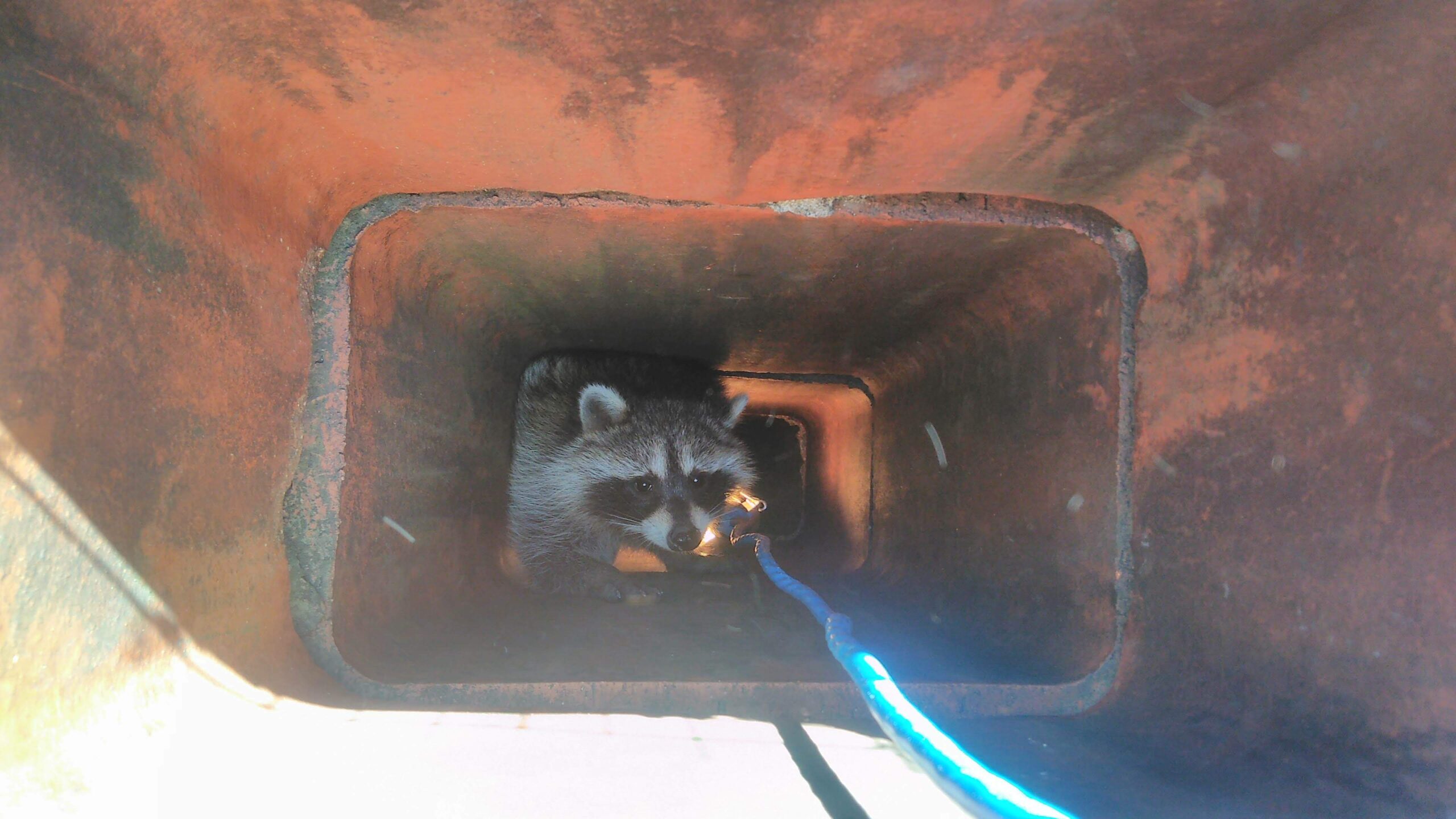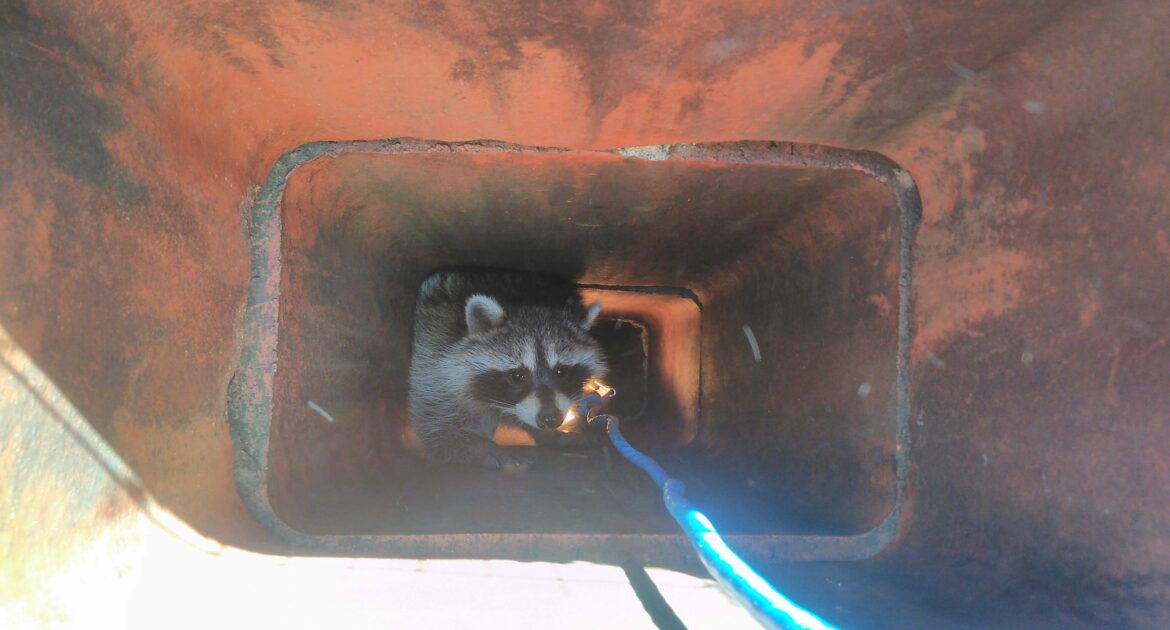Have you ever heard mysterious rustling in your garden late at night? Perhaps you’ve spotted glowing eyes reflecting in your flashlight beam or discovered your garbage cans mysteriously overturned by morning? If you live in Montreal, chances are you’ve encountered one of our city’s most clever and adaptable wildlife residents. Raccoon nighttime behaviour is fascinating to observe, but can sometimes create challenges for homeowners when these masked bandits decide that your property is the perfect playground.
So, what are raccoons really up to after dark? As nocturnal animals, raccoons are most active between dusk and dawn. Their nocturnal raccoon habits include foraging for food, investigating new spaces, and seeking out warm, sheltered spots to rest or nest—often leading them straight into our sheds, attics, chimneys, and crawlspaces. These intelligent mammals have learned to thrive in urban environments, and it’s no surprise to find raccoons in backyards, drawn by accessible trash, pet food, bird feeders, and unsealed entry points. In this blog, we’ll take a closer look at the secret lives of raccoons after sundown and share expert tips to help you minimize unwanted encounters while respecting their role in the local ecosystem.
Urban Adaptation: How Raccoons Thrive in Montreal Neighbourhoods
Raccoons are the ultimate urban adapters. While their natural habitat once comprised forested areas near water sources, they’ve proven themselves exceptional at navigating city landscapes. Montreal’s network of parks, waterways, and residential areas creates an ideal environment for these opportunistic omnivores.
The urban raccoon has evolved specific behaviours that differ from their rural counterparts:
- Urban raccoons often live in closer proximity to each other than their rural relatives due to concentrated food sources.
- City-dwelling raccoons have learned that humans rarely pose immediate threats, leading to bolder behaviour around homes.
- Navigating human structures has made urban raccoons more intelligent, evident in their complex problem-solving skills.
- While naturally nocturnal, urban raccoons may become more active during twilight or even daytime if food opportunities present themselves.
Montreal’s diverse neighbourhoods offer raccoons abundant shelter options. From the leafy suburbs of Westmount to the housing in Hochelaga-Maisonneuve, these adaptable creatures find ways to make themselves at home, sometimes quite literally in your home.
Nocturnal Raccoon Habits: What Happens After Dark?
When the sun sets, raccoons begin their nightly routines. Understanding these nocturnal habits can help homeowners anticipate and prevent potential conflicts.
Foraging Patterns and Feeding Habits
Raccoons are opportunistic feeders with varied diets. Their nightly foraging typically follows established patterns:
- Raccoons usually leave their dens shortly after sunset, with peak activity in the first few hours after darkness falls.
- They explore their territory along familiar routes, checking known food sources in a predictable sequence.
- Urban raccoons visit multiple food sources throughout the night, including natural foods and human-provided opportunities.
- Before daybreak, most raccoons return to their resting places, which might be tree hollows, abandoned burrows, or, unfortunately, your attic or chimney.
Their natural diet includes berries, nuts, insects, small animals, eggs, and aquatic creatures. However, they readily adapt to include leftovers, pet food, garden produce, and more.
Seasonal changes influence raccoon nocturnal behaviour significantly. In summer, they remain active throughout cooler nighttime hours, while winter sees reduced activity during cold periods. Fall brings increased foraging as they build fat reserves for winter.
Social Structure and Communication
While raccoons are often assumed to be solitary, especially in urban environments, their social structure is complex:
- Mother raccoons (sows) raise their young (kits) together, imparting essential survival skills during nighttime excursions.
- At abundant food sources, multiple raccoons may feed in close proximity without significant conflict.
- Raccoons communicate through a range of sounds, including chittering, purring, growling, and screams, serving various social functions.
The Intelligence Behind Raccoon Behaviour
Raccoons are set apart by their remarkable cognitive abilities. Their problem-solving skills rival those of primates in some tests, and this intelligence is particularly evident in their nighttime explorations.
- Raccoons possess a memory capacity allowing them to recall solutions to tasks for up to three years, aiding in activities like accessing garbage bins or gardens.
- Their dexterous front paws function almost like human hands, enabling them to manipulate complex objects, twist doorknobs, and unlatch simple locks.
This intelligence presents unique challenges when dealing with raccoons. Solutions that deter other wildlife may fail with raccoons, who quickly learn to circumvent basic preventative measures.
How Light Pollution Affects Raccoons
Often overlooked is how artificial lighting impacts nocturnal creatures like raccoons. Montreal, like most urban centers, experiences significant light pollution from streetlights, building illuminations, and outdoor lighting.
Disruptions to Natural Patterns
Nocturnal animals like raccoons evolved in environments where darkness was common for roughly half of each 24-hour cycle. Urban lighting disrupts this pattern:
- Excessive lighting can deter some raccoons from bright areas, concentrating their activity in zones like unlit backyards.
- Light pollution alters predator-prey dynamics by making raccoons more visible to predators or humans.
- Artificial light disrupts circadian rhythms, potentially causing behavioural changes and stress.
Adaptation and Opportunity
Despite challenges, raccoons demonstrate remarkable adaptability:
- Urban raccoons navigate light and shadow, using darker corridors between lit areas for safe movement.
- Some raccoons benefit from lighting that illuminates food sources or predator detection.
- Raccoons may adjust their activity to later hours when human activity decreases, and some lighting is reduced.
For homeowners, understanding light’s impact on raccoon behaviour offers practical insights. Strategic lighting can form part of a comprehensive deterrence strategy, while unnecessarily bright outdoor lighting might attract insects that raccoons feed on.
Raccoons in Backyards: Managing Nighttime Visitors
When raccoons frequent your backyard, they present challenges from minor annoyances to serious issues. Here’s how to effectively manage them:
Understanding Attraction Factors
To manage raccoons, it’s essential to recognize what draws them to your property:
- Unsecured garbage, pet food left outdoors, bird feeders, compost bins, and fruit-bearing trees attract hungry raccoons.
- Decorative ponds, birdbaths, and pooled water from irrigation systems serve as water sources.
- Woodpiles, underbrush, hollow trees, deck spaces, sheds, and unused outbuildings offer denning sites.
Effective Prevention Strategies
Based on our extensive experience at Skedaddle, these prevention methods are recommended for properties:
- Secure waste management is a key prevention method. Use containers resistant to wildlife, secure lids with bungee cords or weights, and store bins in garages or sheds until collection day.
- Modify your landscape — trim branches that provide roof access, install motion-activated sprinklers in problem areas, and consider removing dense ground cover near your home.
- Eliminate food sources by feeding pets indoors, removing leftover food after meals, and using animal-proof containers for composting.
Raccoons are undeniably fascinating creatures, but their presence in urban areas poses unique challenges. For homeowners, understanding their nocturnal activities and adapting prevention strategies are vital steps in coexisting peacefully with these skilled nocturnal navigators.
If raccoons are becoming a concern on your property, reach out to Skedaddle to learn more about our safe and effective humane wildlife control solutions. With our extensive experience, we can help protect your home and ensure you and the raccoons live harmoniously within the urban environment.




